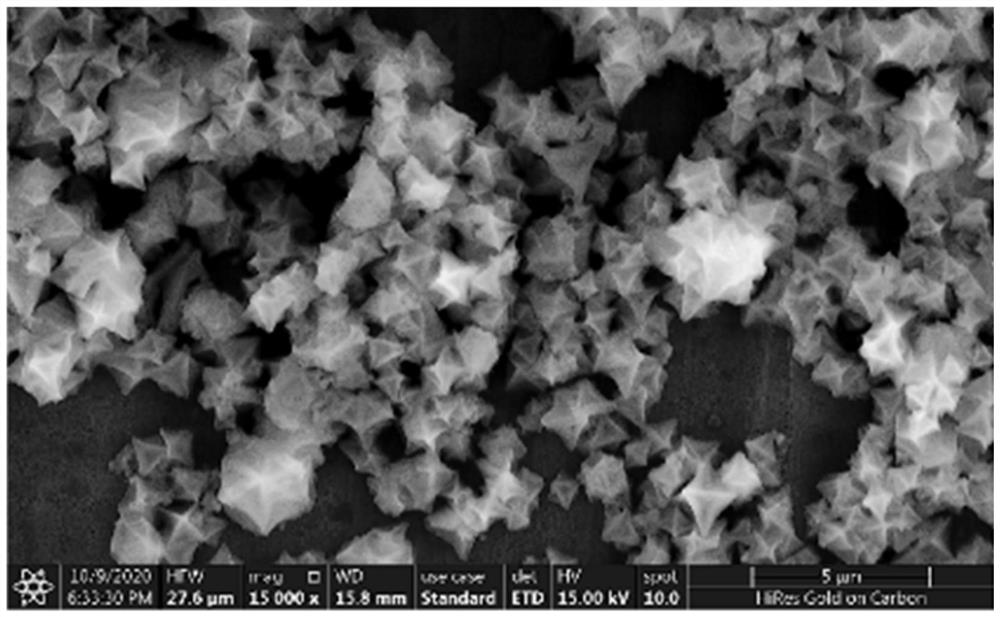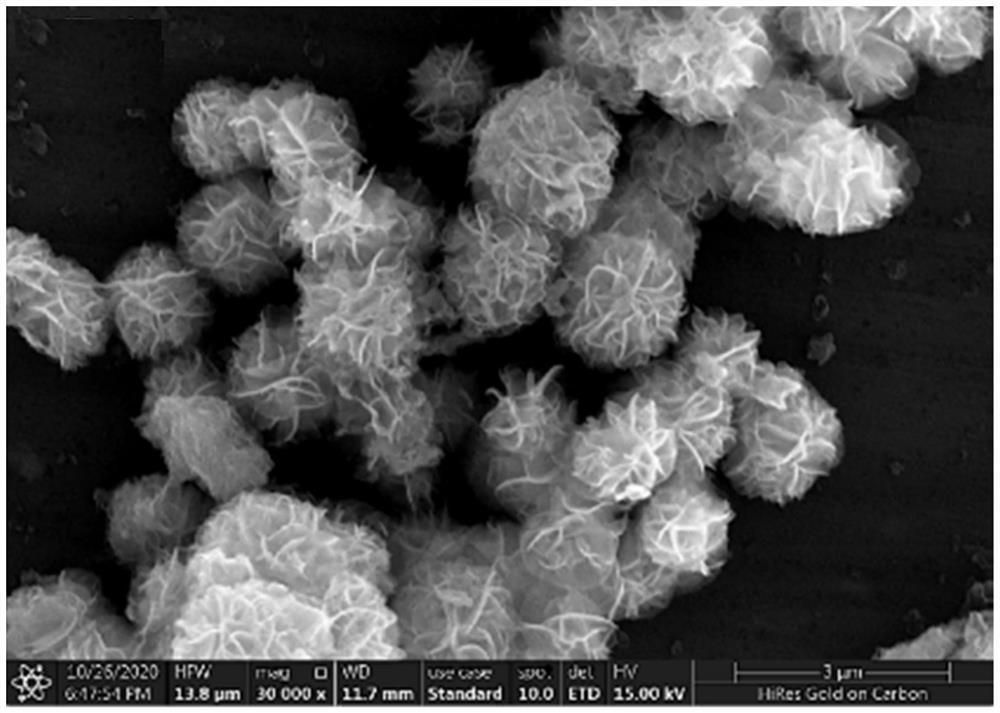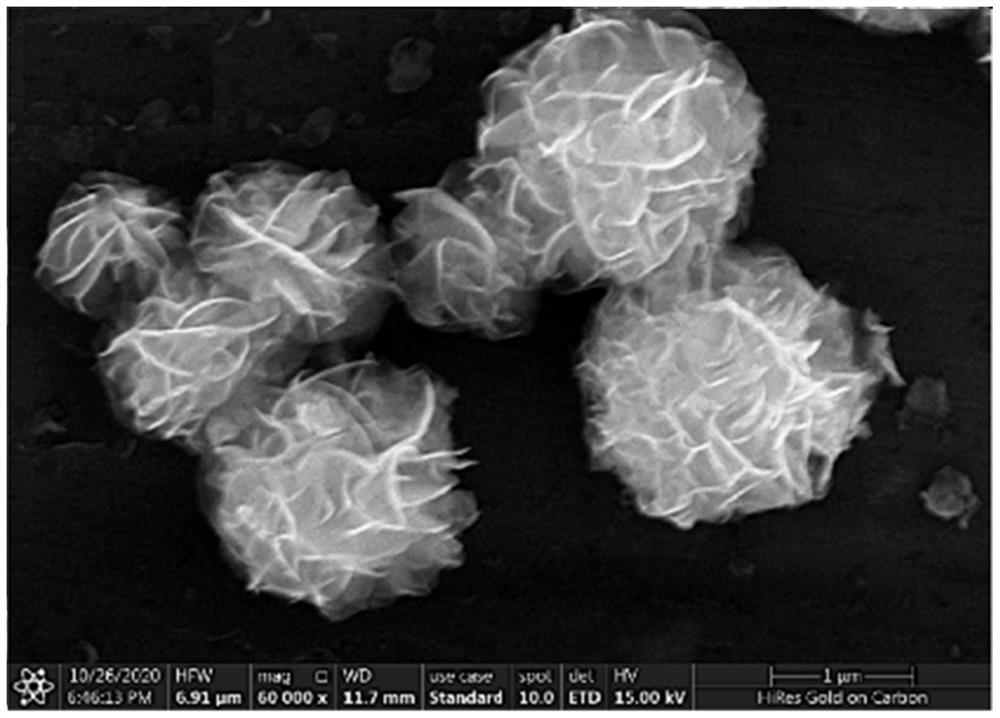Ternary composite antibacterial material with photodynamic-photothermal synergistic antibacterial activity as well as preparation method and application thereof
A photothermal synergy, ternary composite technology, applied in the field of antibacterial materials and environmental protection, can solve the problems of limited photocatalytic antibacterial activity, low electron-hole separation efficiency, easy and rapid recombination, etc., to enhance the photocatalytic antibacterial performance. , Improve the photocatalytic antibacterial activity and the effect of wide visible light absorption
- Summary
- Abstract
- Description
- Claims
- Application Information
AI Technical Summary
Problems solved by technology
Method used
Image
Examples
Embodiment 1
[0040] Step 1, take 4.16mmol FeCl 3 ·6H 2 0 and 2.15mmol 2-aminoterephthalic acid in a beaker, add 50mL solvent DMF and stir until dissolving to obtain the first reaction mixture;
[0041] Step 2. Transfer the first reaction mixture obtained in Step 1 to a polytetrafluoroethylene autoclave (filling ratio 50%), react at 110°C for 24h, and after the reaction is completed, cool to room temperature, centrifuge and wash with water , dried at 50°C for 12 hours, and finally the sample NH 2 -MIL-101(Fe);
[0042] Step 3: Add 0.3g of sodium molybdate dihydrate and 0.4g of thiourea into 40mL of deionized water, and stir until dissolved to obtain a second reaction mixture;
[0043] Step 4, 0.1g of the sample NH obtained in Step 2 2 -MIL-101(Fe) was dispersed in the second reaction mixture obtained in step 3, stirred evenly and ultrasonically treated for 30 minutes; then, the mixture was transferred to a polytetrafluoroethylene autoclave, and reacted at 180°C for 24 hours. Cool to ro...
Embodiment 2
[0047] Step 1, take 4.16mmol FeCl 3 ·6H 2 0 and 2.05mmol 2-aminoterephthalic acid in a beaker, add 50mL solvent DMF and stir until dissolving to obtain the first reaction mixture;
[0048] Step 2. Transfer the first reaction mixture obtained in step 1 to a polytetrafluoroethylene autoclave (filling ratio 50%), react at 100°C for 20 hours, and after the reaction is completed, cool to room temperature, centrifuge and wash with water , dried at 50°C for 12 hours, and finally the sample NH 2 -MIL-101(Fe);
[0049] Step 3: Add 0.3g of sodium molybdate dihydrate and 0.5g of thiourea into 45mL of deionized water, and stir until dissolved to obtain a second reaction mixture;
[0050] Step 4, 0.1g of the sample NH obtained in Step 2 2 -MIL-101(Fe) was dispersed in the second reaction mixture obtained in step 3, stirred evenly and ultrasonically treated for 30 minutes; then, the mixture was transferred to a polytetrafluoroethylene autoclave, and reacted at 200°C for 20 hours. After ...
Embodiment 3
[0054] Step 1, take 4.16mmol FeCl 3 ·6H 2 0 and 2.47mmol 2-aminoterephthalic acid in a beaker, add 50mL solvent DMF and stir until dissolving to obtain the first reaction mixture;
[0055] Step 2. Transfer the first reaction mixture obtained in step 1 to a polytetrafluoroethylene autoclave (filling ratio 50%), react at 105°C for 22 hours, and after the reaction is completed, cool to room temperature, centrifuge and wash with water , dried at 50°C for 12 hours, and finally the sample NH 2 -MIL-101(Fe);
[0056] Step 3: Add 0.3g of sodium molybdate dihydrate and 0.6g of thiourea into 50mL of deionized water, and stir until dissolved to obtain a second reaction mixture;
[0057] Step 4, 0.1g of the sample NH obtained in Step 2 2 -MIL-101(Fe) was dispersed in the second reaction mixture obtained in step 3, stirred evenly and ultrasonically treated for 30 minutes; then, the mixture was transferred to a polytetrafluoroethylene autoclave, and reacted at 220°C for 25 hours. After ...
PUM
 Login to View More
Login to View More Abstract
Description
Claims
Application Information
 Login to View More
Login to View More - Generate Ideas
- Intellectual Property
- Life Sciences
- Materials
- Tech Scout
- Unparalleled Data Quality
- Higher Quality Content
- 60% Fewer Hallucinations
Browse by: Latest US Patents, China's latest patents, Technical Efficacy Thesaurus, Application Domain, Technology Topic, Popular Technical Reports.
© 2025 PatSnap. All rights reserved.Legal|Privacy policy|Modern Slavery Act Transparency Statement|Sitemap|About US| Contact US: help@patsnap.com



